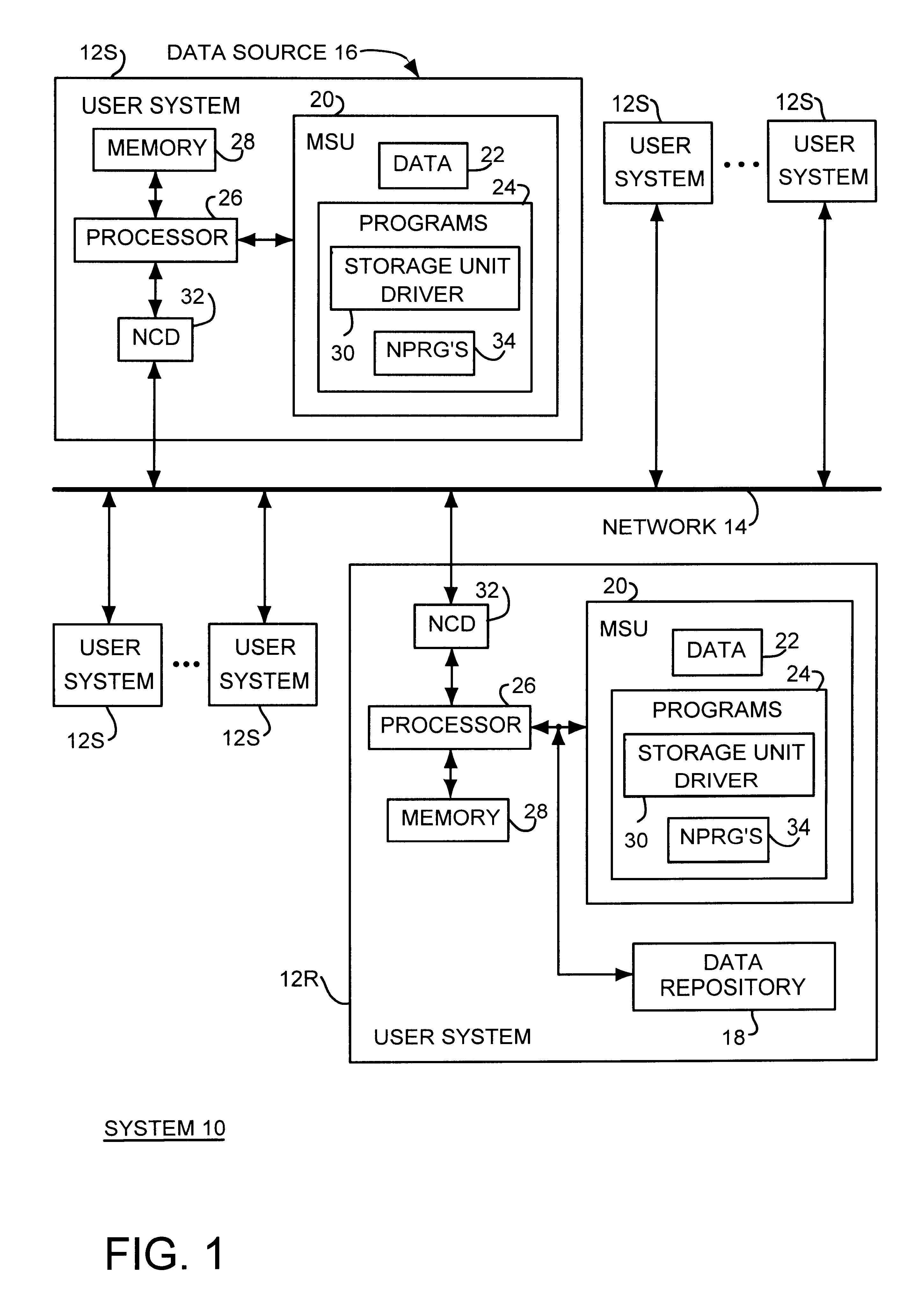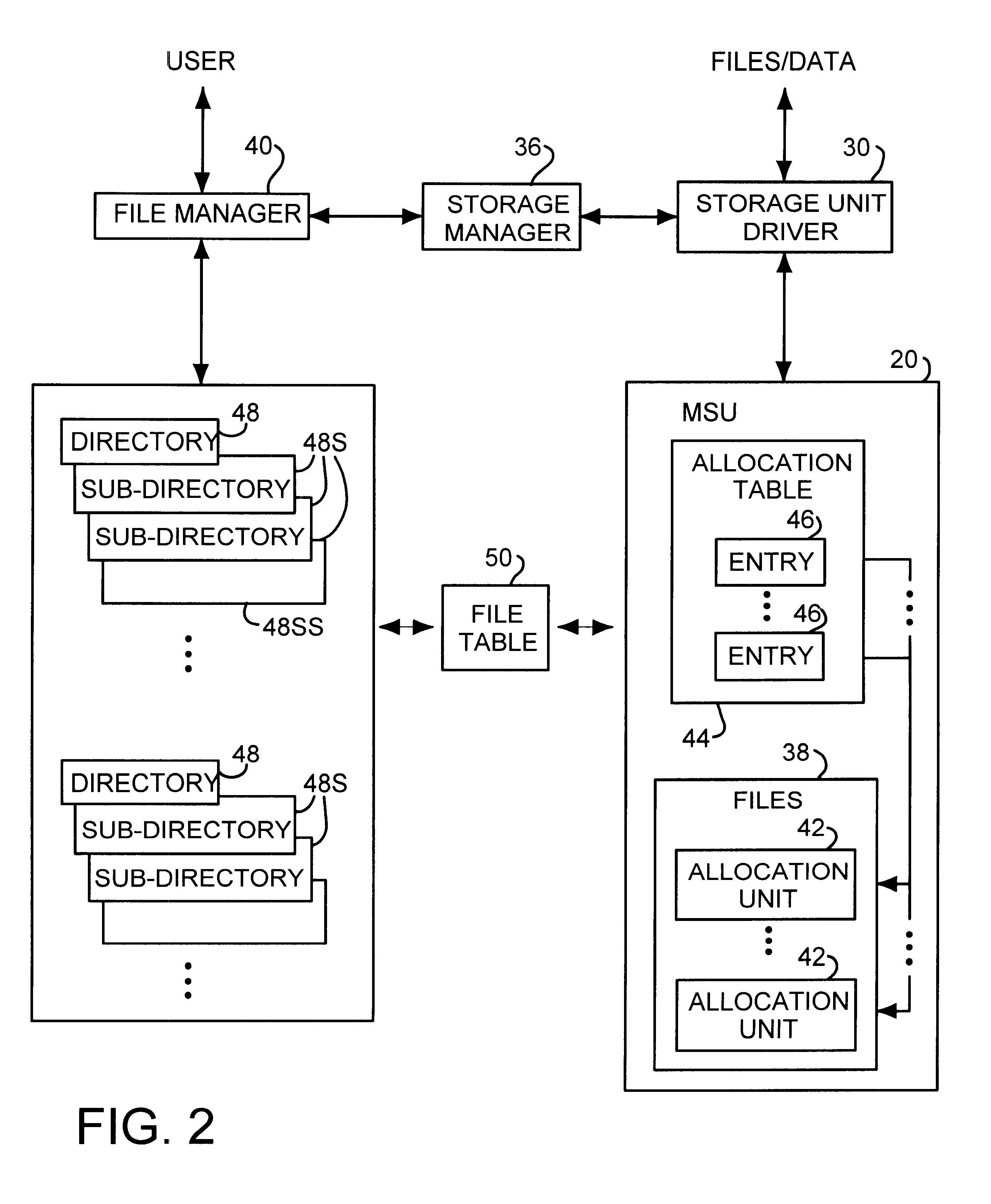A recurring problem in
computer based data
processing systems is the storing of information, such as data files, application programs and
operating system programs, particularly as the size and number of program and data files continues to increase.
This problem occurs in single user / single processor systems as well as in multi-user / multi-processor systems and in multi-processor networked systems and may occur, for example, in the normal operation of a system when the volume of data and programs to be stored in the system exceeds the storage capacity of the system.
The problem occurs more commonly, however, in generating and storing "
backup" or archival copies of a system's program and data files.
Again, this problem occurs commonly in single user systems, and is even more severe in multi-user / multi-processors systems and in networked systems because of the volume of data generated by multiple users and because such systems typically contain multiple copies of application programs and
operating system programs, which are frequently very large.
Traditional methods for storing information, and in particular for storing backup or archival copies of data and program files have offered little relief for this problem.
This method therefore not only does not reduce the volume of data to be stored, but, because the
copying is on the basis of disk drive sectors, does not permit the stored information to be accessed and restored on the basis of files and directories.
It must be recognized, however, that intra-file methods, such as zip compression, do not address many of the problems of data storage, and are at best only a
partial solution to this problem.
As such, intra-file methods generally cannot detect or reduce redundancy in the data between two or more files because the size of the dictionary becomes so large as to not be practical to use and are therefore generally limited to operating on files individually, so that these methods cannot detect and eliminate redundancy even between files that are literal duplicates of one another and cannot reduce the number of files to be stored.
It will be appreciated, however, that these methods again do not address certain significant problems, and in fact present difficulties arising from their inherent characteristics.
Identification of duplicate copies of files by examination of external designators, however, may not identify duplicate copies of files or may misidentify files as duplicates when, in fact, they are not.
Also, certain external designators, such as file modification date, are inherently unreliable for at least certain types of files.
Examination of the actual contents of files to determine whether the files are duplicates of one another, while being a more reliable method for determining whether two or more files are, in fact, duplicates of one another, is generally slow and cumbersome.
It will be appreciated that if this comparison is performed on a
data element by
data element basis, the addition of even a single file to the archive will be a tedious process.
Again, however, a preliminary determination of possible identity between files by examination of external indicators may result in a failure to identify duplicate copies of files, so that the duplicate files are not eliminated, or a misidentifications files as duplicates when they are not, which results in lost
processing time when the contents of the files are compared.
This method has not been used in inter-file compression to represent the actual contents of files for comparison of file contents, however, for a number of reasons.
That is, there is a
high probability that the hash values representing the contents of a
data file or any other form of file that changes frequently would be outdated at any given time and thus would not represent the actual contents of the file, so that a comparison with another file would be invalid.
This would require the regeneration of the hash values each time a file was to be compared to other files, which would slow the operation of the backup / archiving system to an impractical extent, particularly for large files.
Yet another theoretical problem in using hash values on the contents of files to represent the actual contents of files for comparison purposes is what is referred to as the "counting argument", which essentially states that it is mathematically impossible to represent an arbitrary bit
stream of any length greater than M with a value, such as a hash value, having a fixed number of bits N, wherein the value N is a function of the value M and N is less than M. Stated another way, the representation of a bit
stream of length M by a value having N bits, denoted as H(N) is a compression of the bit
stream and it is impossible to perform a
lossless compression of a bit stream of length greater than M into a bit stream having a length N for all possible bit streams of length M. In terms of intra-file compression methods, this means that, in general, the contents of a file cannot be represented uniquely in order to avoid the occurrence of the same hash value for two files having, in fact, different contents.
The result of such an erroneous comparison if an inter-file
compression system would be the loss of the data in one of the files.
Lastly, it should be noted that file backup and archiving systems frequently have yet another related limitation that can become a significant problem, particularly as file sizes become ever larger and especially in multi-user / multi-processor systems where large volumes of data must be stored in a backup or archive facility.
File management systems, however, typically impose a limit on the
maximum size of files, especially in "
disaster recovery"environments, and this size may be exceeded by the cumulative volume of the files to be backed up in a single backup operation.
This, in turn, may require that a backup be performed as multiple partial backups, with increased administrative and
processing burdens and decreases in the
overall efficiency of whatever file
compression method are being used as file compression methods generally cannot be effectively applied across backup operations.
As such, this method cannot duplicate the actual organization of data on disks, which is in clusters (plus some system-related data with is stored as sectors-outside-of-clusters).
As such, the TAPEDISK method, being based on file designators rather than on cluster contents, does not eliminate duplicate data contained in clusters which may be in files with different names.
This method may also fail to identify files having duplicate contents but different names, or may identify two files having the same name but different contents as duplicates.
Again, this method, not being based on clusters or the contents of the actual clusters, cannot duplicate the organization of data on disks, which is in sectors / clusters, and may err by duplicating unchanged files or by not duplicating changed files as the archiving decision is based on the names and attributes of files, such as file name, file modification date, and so forth, rather than on the contents of the files and changes therein.
Further,
JAR.TM. cannot replicate the non-file data exactly.
It is well known and understood that locating and reading a specific, selected body of data from a tape unit, such as to compare the previously stored data with newly received data, is a very slow process and limits the speed of operation of a tape based system severely.
 Login to View More
Login to View More  Login to View More
Login to View More 


